steering CADILLAC DEVILLE 1994 7.G Owners Manual
[x] Cancel search | Manufacturer: CADILLAC, Model Year: 1994, Model line: DEVILLE, Model: CADILLAC DEVILLE 1994 7.GPages: 399, PDF Size: 20.97 MB
Page 8 of 399
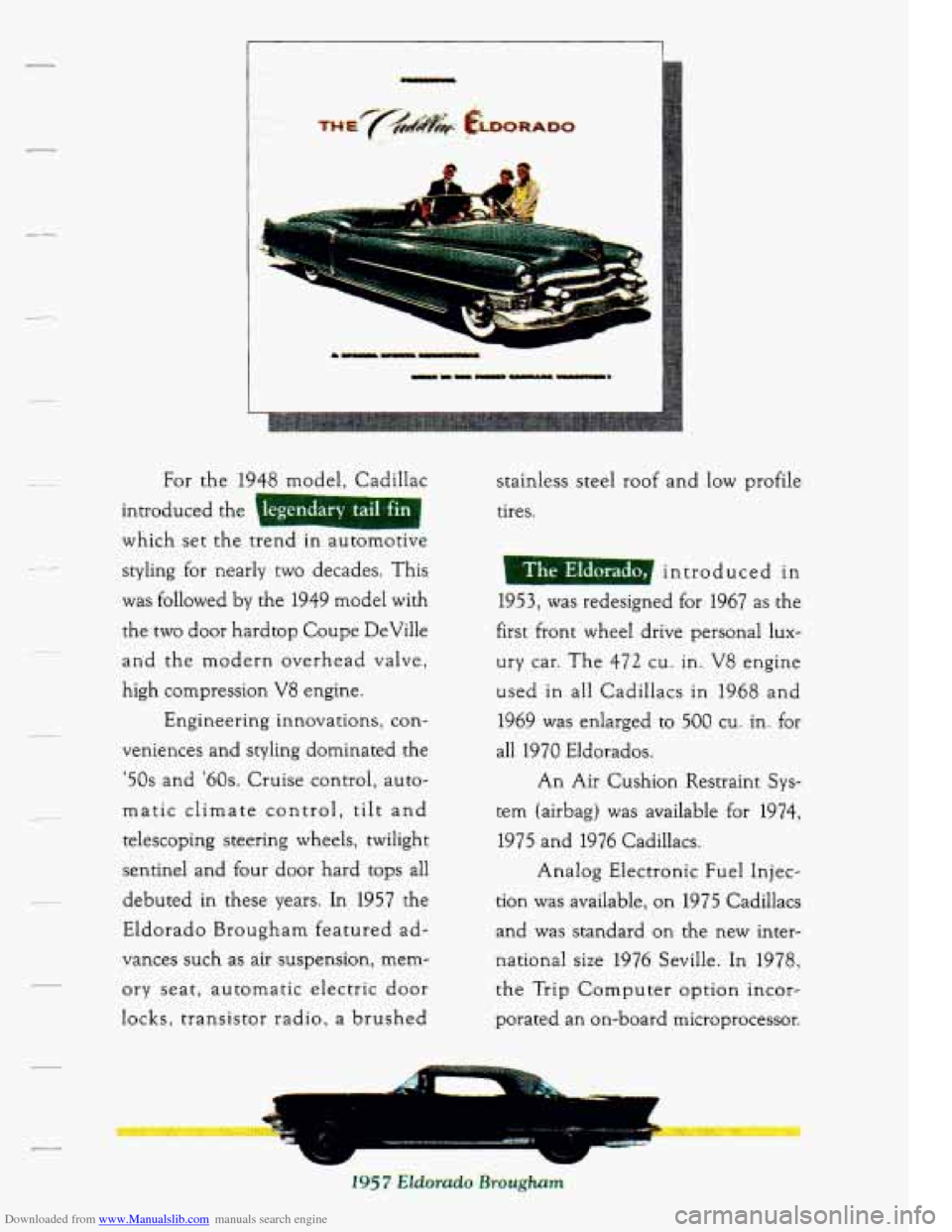
Downloaded from www.Manualslib.com manuals search engine r_
1
For the 1948 model, Cadillac
introduced the
e
which set the trend in automotive styling for nearly two decades. This
was followed
by the 1949 model with
the two door hardtop Coupe DeVille
and the modern overhead valve,
high compression V8 engine.
Engineering innovations, con-
veniences and styling dominated the
'50s and '60s. Cruise control, auto-
matic climate control,
tilt and
telescoping steering wheels, twilight
sentinel and four door hard tops all
debuted in these years. In 1957 the
Eldorado Brougham featured
ad-
vances such as air suspension, mem-
ory seat, automatic electric door
locks, transistor radio, a brushed stainless steel
roof and low profile
tires.
1953, was redesigned for 1967 as the
first front wheel drive personal lux-
ury car. The
472 cu. in. V8 engine
used
in all Cadillacs in 1968 and
1969 was enlarged to 500 cu. in. for
all 1970 Eldorados.
An Air Cushion Restraint Sys-
tem (airbag) was available for
1974,
1975 and 1976 Cadillacs.
Analog Electronic Fuel Injec-
tion was available, on
1975 Cadillacs
and was standard
on the new inter-
national size 1976 Seville. In
1978,
the Trip Computer option incor-
porated an on-board microprocessor.
Page 9 of 399
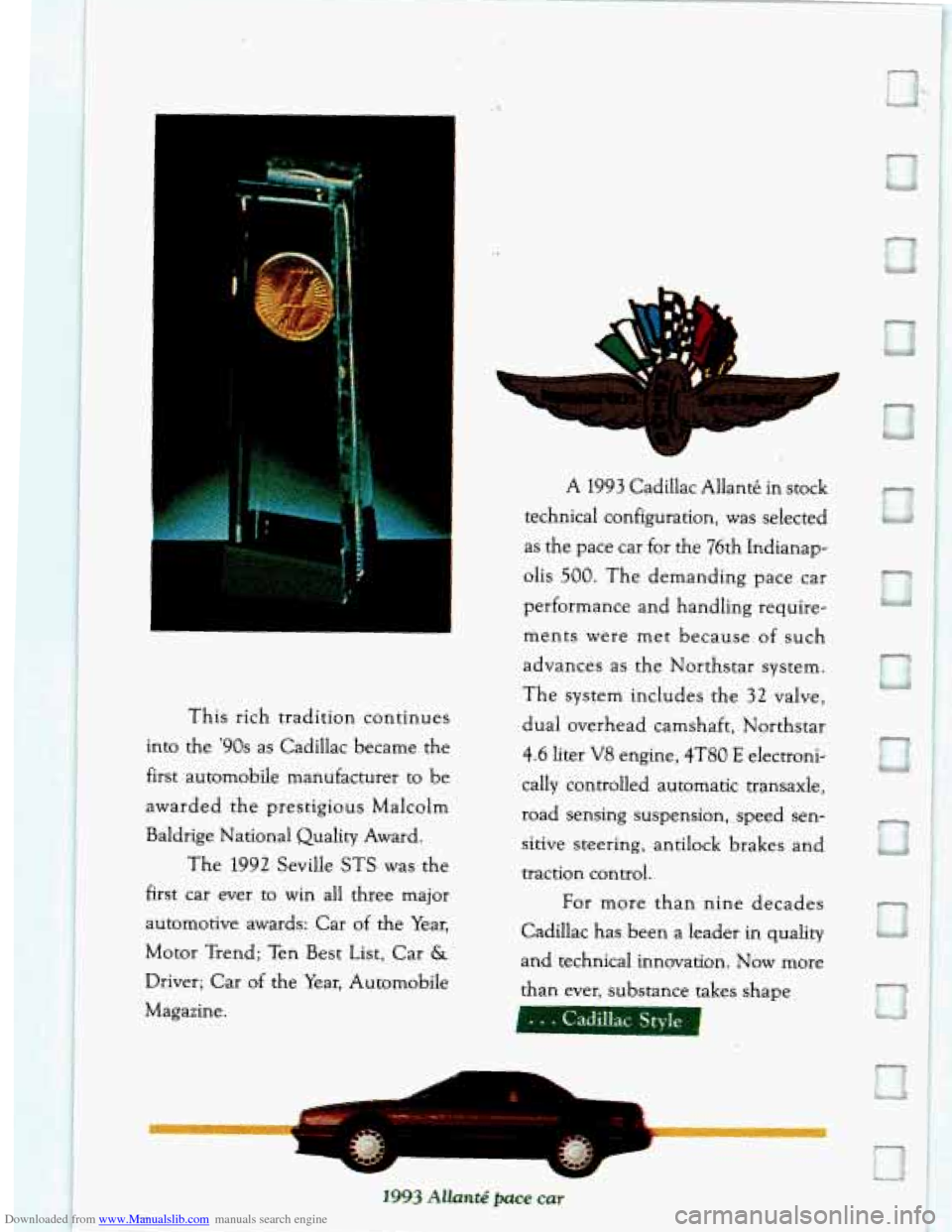
Downloaded from www.Manualslib.com manuals search engine 1.
I
This rich tradition continues
into the
'90s as Cadillac became the
first automobile manufacturer
to be
awarded the prestigious Malcolm
Baldrige National Quality Award.
The
1992 Seville STS was the
first car ever to win
all three major
automotive awards: Car of the Year,
Motor Trend; Ten Best List, Car
&
Driver; Car of the Year, Automobile
Magazine.
-
A 1993 Cadillac Allantit in stock
technical configuration, was selected
as the pace car for the 76th Indianap-
olis
500. The demanding pace car
performance and handling require- ments were met because of such
advances as the Northstar system.
The system includes the
32 valve,
dual overhead camshaft, Northstar
4.6 liter V8 engine, 4T80 E electroni-
cally controlled automatic transaxle,
road sensing suspension,. speed sen-
sitive steering, antilock brakes and
traction control. For more than nine decades
Cadillac has been
a leader in quality
and technical innovation. Now more
than ever, substance takes shape
Page 48 of 399
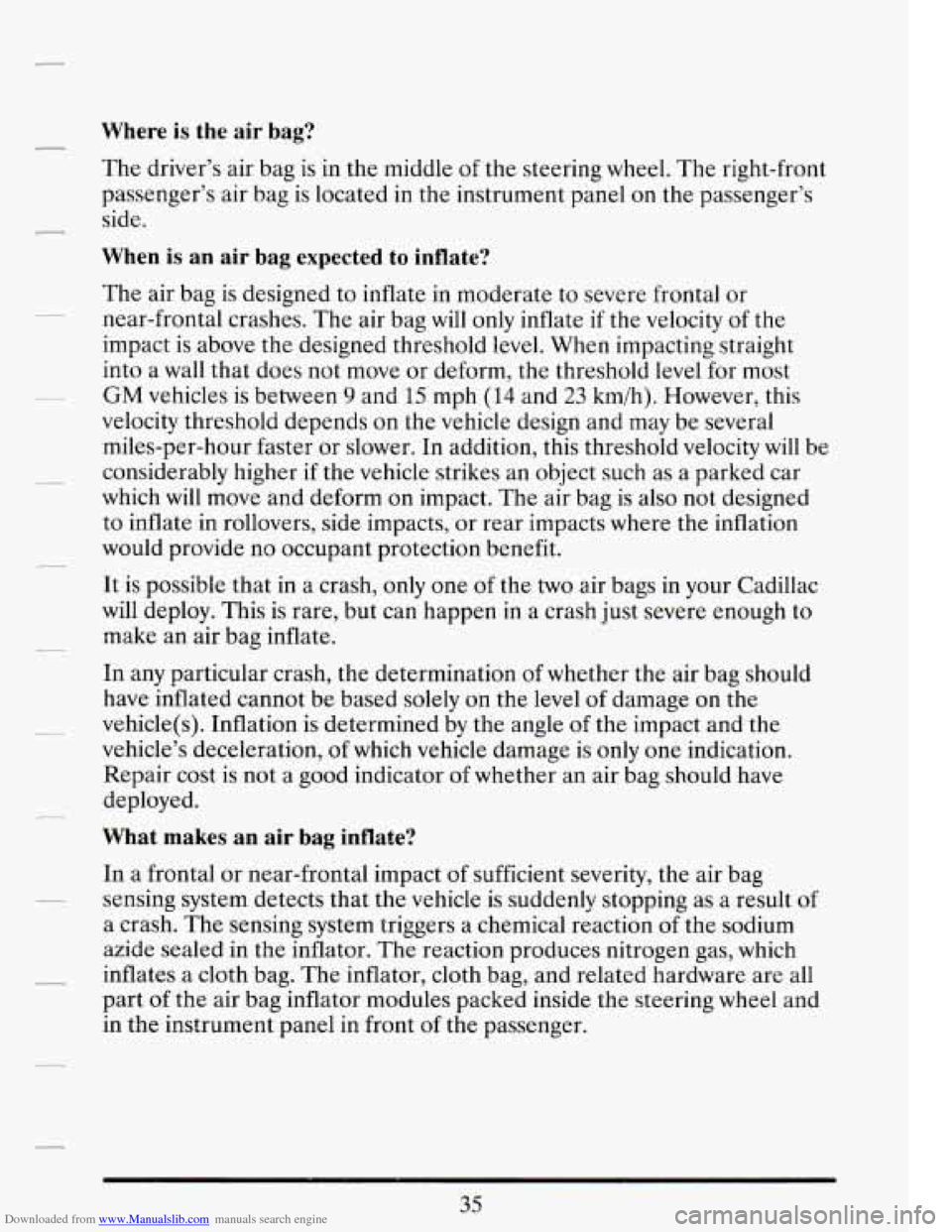
Downloaded from www.Manualslib.com manuals search engine Where is the air bag?
The driver’s air bag is in the middle of the steering wheel. The right-front
passenger’s air bag is located in the instrument panel
on the passenger’s
side.
When is an air bag expected to inflate?
The air bag is designed to inflate in moderate to severe frontal or
near-frontal crashes.
The air bag will only inflate if the velocity of the
impact is above the designed threshold level. When impacting straight
into a wall that does not move or deform, the threshold level for most
GM vehicles is between 9 and 15 mph (14 and 23 km/h). However, this
velocity threshold depends
on the vehicle design and may be several
miles-per-hour faster or slower. In addition, this threshold velocity will be
considerably higher
if the vehicle strikes an object such as a parked car
which will move and deform on impact.
The air bag is also not designed
to inflate in rollovers, side impacts, or rear impacts where the inflation
would provide no occupant protection benefit.
It
is possible that in a crash, only one of the two air bags in your Cadillac
will deploy. This is rare, but can happen in a crash just severe enough to
make an
air bag inflate.
In any particular crash, the determination
of whether the air bag should
have inflated cannot be based
solely on the level of damage on the
vehicle(s). Inflation is determined by the angle
of the impact and the
vehicle’s deceleration,
of which vehicle damage is only one indication.
Repair cost is not a good indicator
of whether an air bag should have
deployed.
What makes an air bag inflate?
In a frontal or near-frontal impact of sufficient severity, the air bag
sensing system detects that the vehicle is suddenly stopping as a result
of
a crash. The sensing system triggers a chemical reaction of the sodium
azide sealed in
the inflator. The reaction produces nitrogen gas, which
inflates
a cloth bag. The inflator, cloth bag, and related hardware are all
part
of the air bag inflator modules packed inside the steering wheel and
in the instrument panel in front
of the passenger.
35
Page 49 of 399
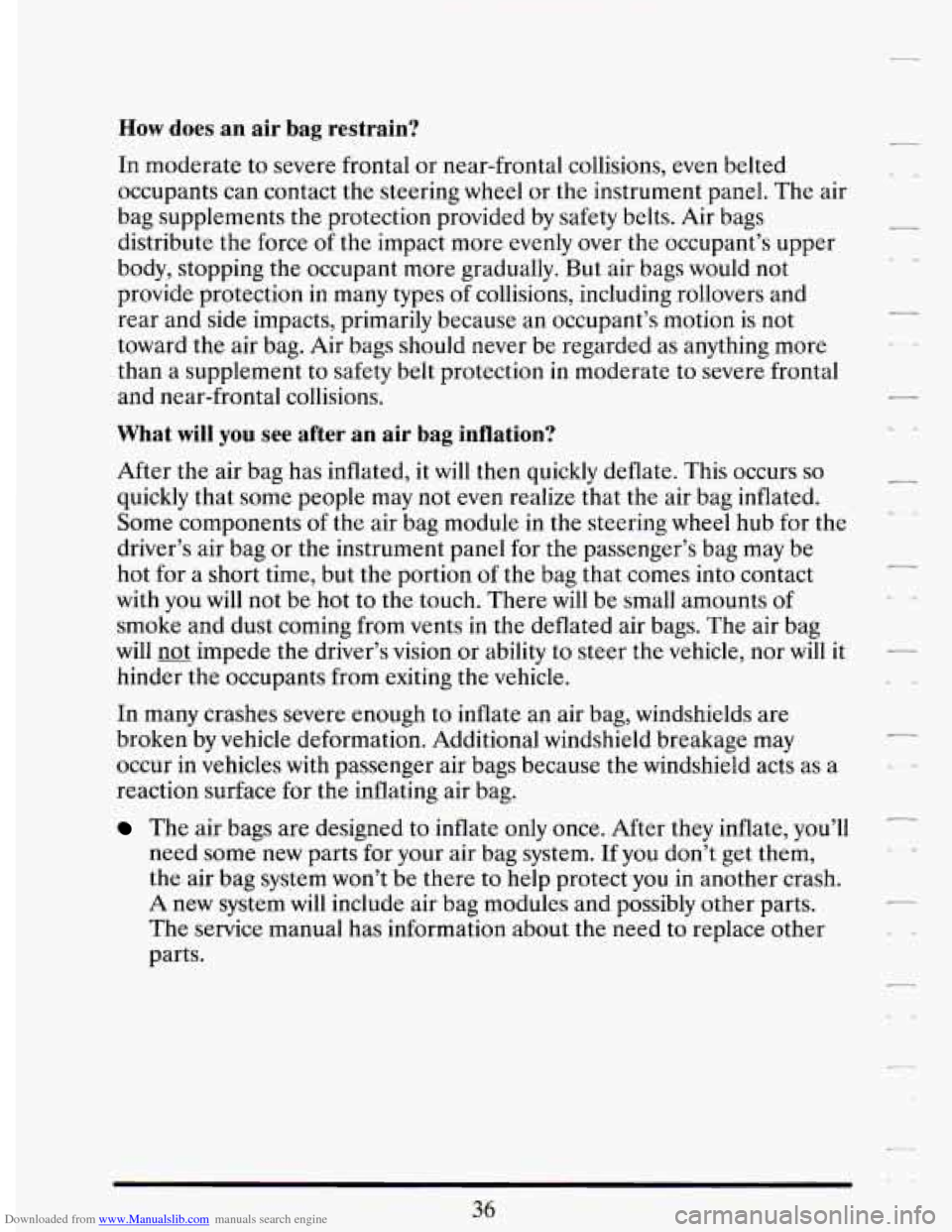
Downloaded from www.Manualslib.com manuals search engine How does an air bag restrain?
In moderate to severe frontal or near-frontal collisions, even belted
occupants can contact the steering wheel or the instrument panel.
The air
bag supplements the protection provided by safety belts. Air bags
distribute the force of the impact more evenly over the occupant’s upper
body, stopping the occupant more gradually. But air bags would not
provide protection in many types of collisions, including rollovers and
rear and side impacts, primarily because an occupant’s motion is not
toward the air bag. Air bags should never be regarded as anything more
than a supplement to safety belt protection
in moderate to severe frontal
and near-frontal collisions.
What will you see after an air bag inflation?
After the air bag has inflated, it will then quickly deflate. This occurs so
quickly that some people may not even realize that the air bag inflated.
Some components
of the air bag module in the steering wheel hub for the
driver’s air bag or the instrument panel for the passenger’s bag may be
hot for a short time, but the portion of the bag that comes into contact
with
you will not be hot to the touch. There will be small amounts of
smoke and dust coming from vents in the deflated air bags. The air bag
will
not impede the driver’s vision or ability to steer the vehicle, nor will it
hinder the occupants from exiting the vehicle.
In many crashes severe enough to inflate an air bag, windshields are
broken by vehicle deformation. Additional windshield breakage may
occur in vehicles with passenger air bags because the windshield acts as a
reaction surface for the inflating air bag.
The air bags are designed to inflate only once. After they inflate, you’ll
need some new parts for your air bag system.
If you don’t get them,
the air bag system won’t be there to help protect you in another crash.
A new system will include air bag modules and possibly other parts.
The service manual has information about the need to replace other
parts.
36
Page 50 of 399
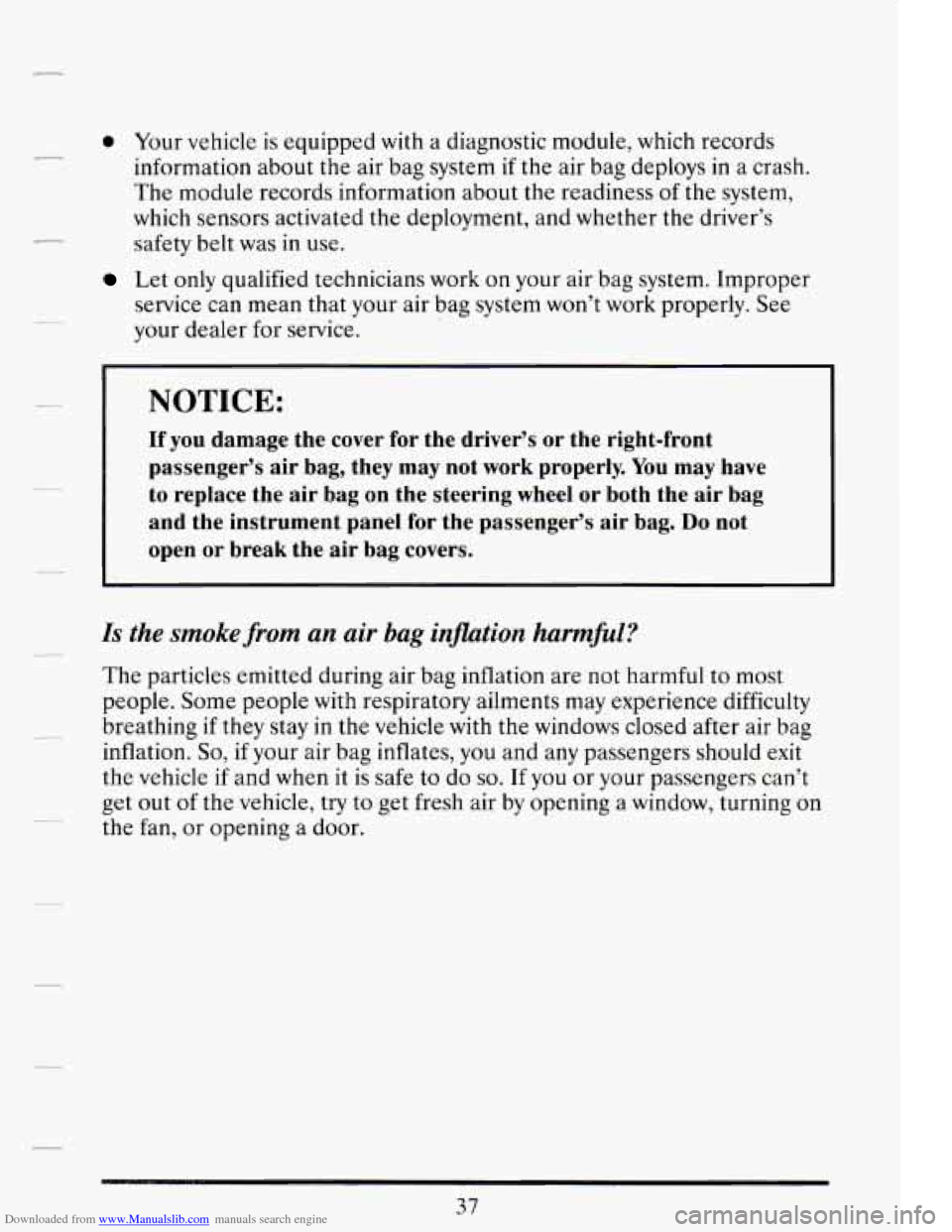
Downloaded from www.Manualslib.com manuals search engine 0 Your vehicle is equipped with a diagnostic module, which records
information about the air bag system
if the air bag deploys in a crash.
The module records information about the readiness of the system,
which sensors activated the deployment, and whether the driver’s
safety belt was
in use.
Let only qualified technicians work on your air bag system. Improper
service can mean that your air
.. bag system won’t work properly. See
your dealer for service.
NOTICE:
If you damage the cover for the driver’s or the right-front\
passenger’s air bag, they may not work properly.
You may have
to replace the air bag on the steering wheel or both the air bag
and the instrument panel for the passenger’s air bag.
Do not
open
or break the air bag covers.
Is the smoke from an air bag inflation harmful?
The particles emitted during air bag inflation are not harmful to most
people. Some people with respiratory ailments may experience difficulty
breathing
if they stay in the vehicle with the windows closed after air bag
inflation.
So, if your air bag inflates, you and any passengers should exit
the vehicle
if and when it is safe to do so. If you or your passengers can’t
get out of the vehicle, try to get fresh air by opening a window, turning
on
the fan, or opening a door.
37
Page 94 of 399

Downloaded from www.Manualslib.com manuals search engine A CAUTION
It can be dangerous to drive with the trunk Iid open because
carbon monoxide
(CO) gas can come into your vehicle. You can’t
see
or smell CO. It can cause unconsciousness and even death.
If you must drive with the trunk lid open or if electrica1 wiring
or other cable connections must pass through the seal between
the body and the trunk
lid
Make sure all windows are shut.
Turn the fan on your heating or cooling system to its highest
speed with the setting on between
65 F (18” C) to 85 F
(29O C). That will force outside air into your vehicle. See
“Comfort Controls” in the Index.
See ‘4Engine Exhaust” in. the Index.
THEFT
Vehicle theft is big business, especially in some cities. Although your
we put on it can make it impossible to steal. However, there are ways
you
can help.
__ Cadillac has a number of theft deterrent features, we know that nothing
Key in the ignition
If you walk away from your vehicle with the keys inside, it’s an easy target
When
you park your Cadillac and open the driver’s door, you’ll hear a
chime reminding you to remove your key
fr9m the ignition and take it
with you. Always
do this. Your steering wheel will be locked, and so will
your ignition and transaxle. And remember to lock the doors.
~ for joy riders or professional thieves -- so don’t do it.
81
Page 99 of 399

Downloaded from www.Manualslib.com manuals search engine IGNITION KEY POSITIONS
This lock gives you five ’’
different positions.
Before you put the key in, your ignition will be
in the “LOCK’ position.
This position locks your ignition, steering wheel and transaxle. It’s an
anti-theft feature.
The other positions let you perform these functions:
ACC: Accessory lets you use things like the radio and the windshield
wipers when the engine is off.
To get into “ACC”, push in the key and turn
it toward you. Your steering wheel.wil1 remain locked, just as it was
before you inserted the key.
OFF: This position lets you turn off the engine.but still turn the steering
wheel. It doesn’t lock the steering wheel like “Lock.” Use “Off”
if you
must have your car
in motion while the engine is off (for example, if your
car is being pushed).
RUN This is the position for driving.
STARE This starts your engine.
86
L
Page 100 of 399

Downloaded from www.Manualslib.com manuals search engine NOTICE:
If your key seems stuck in “Lock” and you can’t turn it, be sure
it is all the
way in. If it is, then turn the steering wheel left and
right while you turn the key hard. But turn the key only with
your hand. Using a tool to force it could break the key or the
ignition switch. If none of this works, then your vehicle needs
service.
STARTING YOUR ENGINE
Move your shift lever to “P” (Park) or “N” (Neutral). Your engine won’t
start in any other position
-- that’s a safety feature. To restart when you’re
already moving, use
“N” (Neutral) only.
NOTICE:
Don’t try to shift to “P” (Park) if your Cad,illac is moving. If you
do, you
could damage the transaxle. Shift to “P” (Park) only
when your vehicle is stopped.
1. Don’tpush the accelerator pedal before starting your engine. In some
other vehicles you might need to do this, but because
of your vehicle’s
computer systems, you don’t.
2. Turn your ignition key to “Start.” When the engine starts, let go of the
key. The idle speed
will go down as your engine gets warm.
3. If it doesn’t start right away, hold your key in “Start ” for about three
seconds at a time until your engine starts. Wait about
15 seconds
between each
try to help avoid draining your battery.
87
Page 103 of 399

Downloaded from www.Manualslib.com manuals search engine AUTOlMATIC TRANSAXLE
Your automatic transaxle shift lever is located on the steering column.
There are several different positions for your shift lever.
P
..................................................... Park
R
................................................. Reverse
N ................................................. Neutral
@ ............................................... Overdrive
3 ........................................ Third Gear (Drive)
2 ............................................. SecondGear
l................................................FirstGear
LI
k.
90
Page 110 of 399

Downloaded from www.Manualslib.com manuals search engine - Steering Column Shift Lever
1. Hold the brake pedal down with your right foot.
2. Move the shift lever into “P” (Park) position like this:
3.
4.
5.
0 Pull the lever
toward you.
0 Move the lever
up as far as it
will
go.
With your right foot still holding the brake pedal down, set the
parking brake.
Move the ignition key to “Lock.”
Remove the key and take it with you.
If you can walk away from your
vehicle with the ignition key in your hand, your vehicle is in “P” (Park).
97